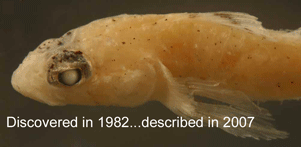 In 12 July 2007 Zootaxa, Benjamin Victor, Ocean Science Foundation and Nova Southeastern University, describes a new species of goby Coryphopterus kuna from the western Caribbean. Although species descriptions often cite DNA sequence differences as evidence for species status, the sequence data itself is usually not shown. Victor’s work is the first vertebrate species description that includes the holotype mtCOI DNA barcode, a simple step that will enable more persons to identify this fish regardless of life stage (egg, larva, and adult forms of an individual all have the same DNA of course) or whether specimen is in bits and pieces, as in stomach contents of a predator for example. (For a look at the strange diversity of fish larva, see Victor’s web-based photographic guide to larval fishes of the Caribbean).
In 12 July 2007 Zootaxa, Benjamin Victor, Ocean Science Foundation and Nova Southeastern University, describes a new species of goby Coryphopterus kuna from the western Caribbean. Although species descriptions often cite DNA sequence differences as evidence for species status, the sequence data itself is usually not shown. Victor’s work is the first vertebrate species description that includes the holotype mtCOI DNA barcode, a simple step that will enable more persons to identify this fish regardless of life stage (egg, larva, and adult forms of an individual all have the same DNA of course) or whether specimen is in bits and pieces, as in stomach contents of a predator for example. (For a look at the strange diversity of fish larva, see Victor’s web-based photographic guide to larval fishes of the Caribbean).
The process that leads to taxonomic recognition of new species is often glacially slow. In this case the holotype specimen was collected off the coast of Panama in 1982, twenty-five years ago. Just as the Human Genome Project generated enormous amounts of raw sequence data, genetic explorations of biodiversity, including DNA barcoding, are creating vast amounts of data that outpace the ability of traditional species descriptions to keep up. Making the sequence and specimen data available through public databases in BOLD and GenBank might lead others to find to new ways of analyzing biodiversity in addition to the stately process of formal species descriptions.
Being a novice myself, I was very intrigued by this article. My favorite part was…
“Victor’s work is the first vertebrate species description that includes the holotype mtCOI DNA barcode, a simple step that will enable more persons to identify this fish regardless of life stage (egg, larva, and adult forms of an individual all have the same DNA of course) or whether specimen is in bits and pieces, as in stomach contents of a predator for example.”
Identify, even in pieces, to determine it’s predators? It was one of those “ah ha” moments.